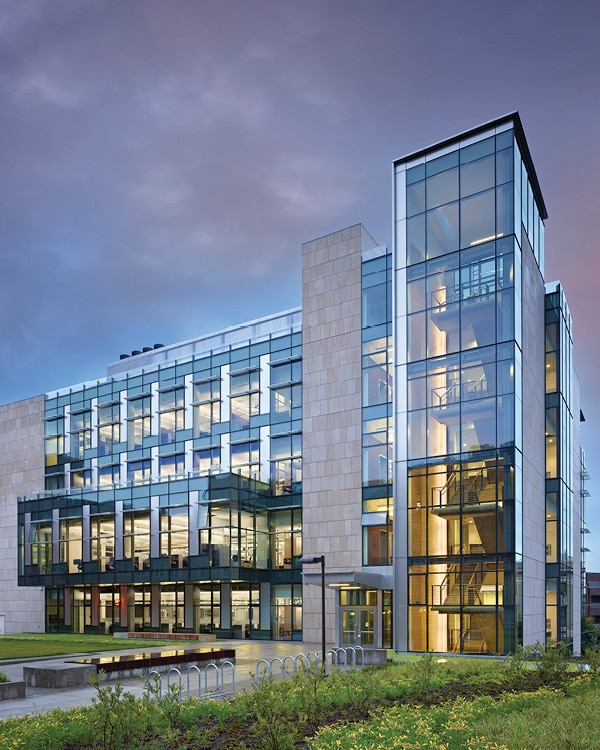Seattle summers have been unusually hot in recent years, but students and researchers at the University of Washington’s new Molecular Engineering Laboratory have managed to stay quite comfortable. And it may come as a surprise that they do so without the help of air conditioning.
In 2013, the university partnered up with Affiliated Engineers, Inc. and architecture firm ZGF Architects to begin designing and constructing the new lab. Engineers from AEI searched for ventilation solutions that would create a comfortable environment while keeping costs low. They stumbled upon a new system by Edmonds, a leading producer of energy efficient ventilation solutions. Edmonds had blended gravity and mechanical ventilation to achieve serious energy efficiency with a product that suited the university’s needs perfectly—the ecoPOWER Hybrid Roof Ventilator.
“They didn’t start out looking for a hybrid roof ventilator because none existed before this!” explains director of Edmonds USA Kurt Shafer. “The ecoPOWER is the first one of its kind. And the Edmonds product happened to fit their needs perfectly.”
Bruce McLay of Affiliated Engineers, Inc. served as the project manager for AEI on the UW project; he explains why the hybrid design suited the University’s needs. “We decided to incorporate solar chimneys into the design of the gravity ventilation system, and adding some type of wind-driven feature made sense for us. The fact that the system can be passive or active was important,” he says.

Noteworthy: This is the first UW lab building with offices that use natural ventilation instead of mechanical air conditioning. In addition to the ecoPOWER hybrid roof ventilators that draw hot air up and out, natural ventilation in office spaces is provided by windows that open and electronically controlled ceiling fans. To add to the sustainability of the building, two rain gardens control storm water, and three rooftop gardens absorb and filter storm water and moderate building temperatures. PHOTO: BEN BENSCHNEIDER
Breathing Fresh Air into Ventilation Methods
To understand why the ecoPOWER is so effective, one first needs to understand what exactly distinguishes a hybrid roof ventilator from traditional models. Purely gravity roof ventilators use upward movement of warm air, as well as the power of the wind to turn turbines, which draw air up and out of a building. Mechanical roof ventilators rely on electric motors to actively move the air up the shaft and out through the ventilator.
Edmonds’s ecoPOWER Hybrid Roof Ventilator is unique because it combines both gravity and mechanical modes. On many days, upward momentum of warm air and the wind-actuated turbines are enough to cool the facility. On very hot days when the gravity mode is not enough, it switches to mechanical mode, which engages the motor to actively move more warm air out. The two modes can also work simultaneously.
“The engineers who do research here like the idea that engineering solved this problem,” says Steve Tatge, executive director of Major Capital Projects at the University. “And people who are in a lab environment many hours a day appreciate the fact that you can open the windows to the fresh air outside. You can’t do that in a more controlled air conditioned environment.”
Clean, Quiet, and Low Maintenance

By utilizing ecoPOWER ventilators, you can have comfortable office spaces that are not air conditioned. PHOTO: BEN BENSCHNEIDER
The ecoPOWER ventilators are much quieter than traditional motorized ventilators (essentially inaudible in typical background noise), and are also low-maintenance. They are made from marine grade aluminum, which makes them lightweight and easy to install. Allan Ramsay, export manager for Edmonds, credits the motor, which is manufactured by ebm papst of Germany, for the system’s reliability.
“It’s an electronically commutated motor, which is the newest of motor technologies,” he explains. “ebm papst was really the forerunner on these. They don’t have brushes; they work with magnetism. So there is nothing to maintain in them. They don’t need oil, grease, nothing.”

PHOTO: BEN BENSCHNEIDER
What Hybrid Designs Mean for the Future of Ventilation
The university credits the ecoPOWER ventilators for helping the laboratory achieve LEED Gold certification. They have been deemed such a success that they will also be used in the school’s construction of a new Nano Engineering and Sciences building, which is slated for completion by April 2017.
Tatge will also oversee this upcoming installation of ecoPOWER ventilators and says that the installation is a symbol for the university’s movement toward greater energy efficiency. “Its not even so much about the specific success of the Molecular Engineering lab or the upcoming Nano Lab project,” he says. “ By utilizing ecoPOWER ventilators you can have comfortable office spaces that are not air conditioned. That’s an even bigger story for me. This could influence how we design campus buildings in the future.”

Download a PDF of this story here.
Connect with Edmonds: Website
![]()

